When Pascal Jansen was installed as interim boss at AZ Alkmaar in December 2020 after Arne Slot‘s dismissal, not many knew what to expect from the former Jong PSV boss.
Jansen finished the season well with AZ before it was cancelled due to Covid, with him being rewarded a new contract as a result.
Though they were knocked out of the Europa Conference League by Norwegian side FK Bodø/Glimt in the round of 16, Jansen has the Alkmaar-based side sitting in fifth place in the Eredivisie, six points behind former manager Arne Slot’s Feyenoord side.
This successful season from AZ is despite losing key players in last summer’s transfer window.
Both Myron Boadu and Calvin Stengs moved to France, joining AS Monaco and OGC Nice, respectively.
Club captain Teun Koopmeiners was also sold, joining Serie A side Atalanta.
Last season’s starting goalkeeper, Marco Bizot, was also sold, joining French side Stade Brestois.
They recruited well in the summer and put their trust in Jansen, and he has repaid them.
The club look destined to qualify for Europe again next season, where they will hope to progress further.
This tactical analysis will examine Pascal Jansen’s style of play and some of the tactics he has employed to great success so far this season.
Pascal Jansen Tactics – Creating space in the wide channels in the final third
When it comes to attacking sequences for AZ Alkmaar under Pascal Jansen’s tactics this season, there has been a heavy emphasis on utilising wide play in the final third, with crosses into the box being the typical end result.
So far this season, AZ have attempted the third most crosses in the league with 509 while averaging 16.29 per 90 minutes.
The most important statistical figure, however, is the accuracy of these crosses.
40.9% of the attempted crosses from AZ have been successful, the best in the Eredivisie.
This section will examine these attacking sequences and illustrate the AZ players’ off-the-ball movements to create space in the wide channels.
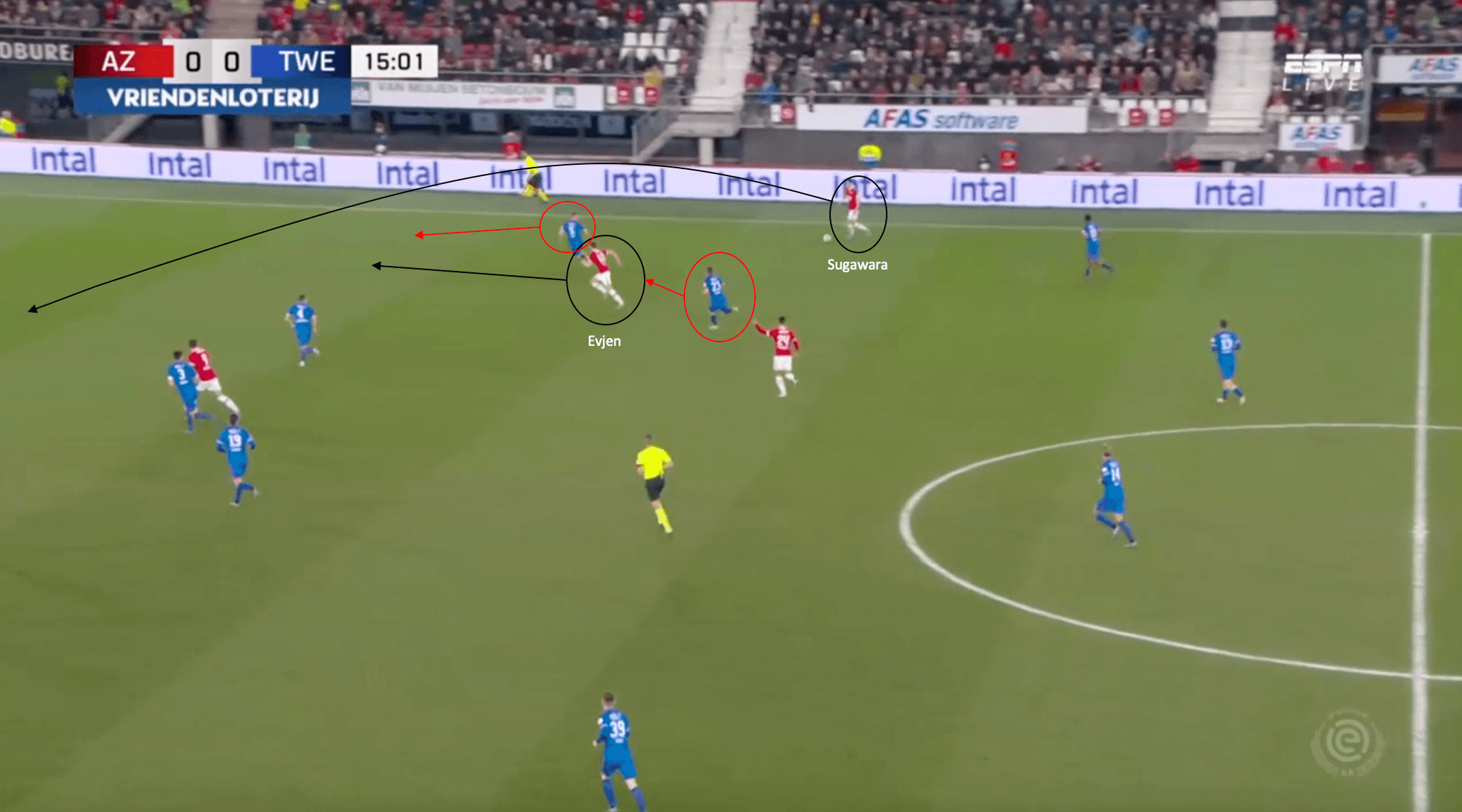
This attacking phase above from AZ’s recent match against FC Twente shows an example of utilising the off-the-ball runners to create space for crossing opportunities.
In the image above, Håkon Evjen is making an underlapping run inside of fullback Yukinari Sugawara.
This run attracts the attention of both the Twente fullback and central midfielder, who expect Sugawara to send a through ball in behind the defence to find Evjen.
However, Sugawara instead sends a very good cross into the box, just missing the head of Dani de Wit, who was unmarked near the penalty spot.
These off-the-ball movements create space and time for either the fullback or wide CAMs to cross, which illustrates why AZ has the best crossing accuracy in the Eredivisie.
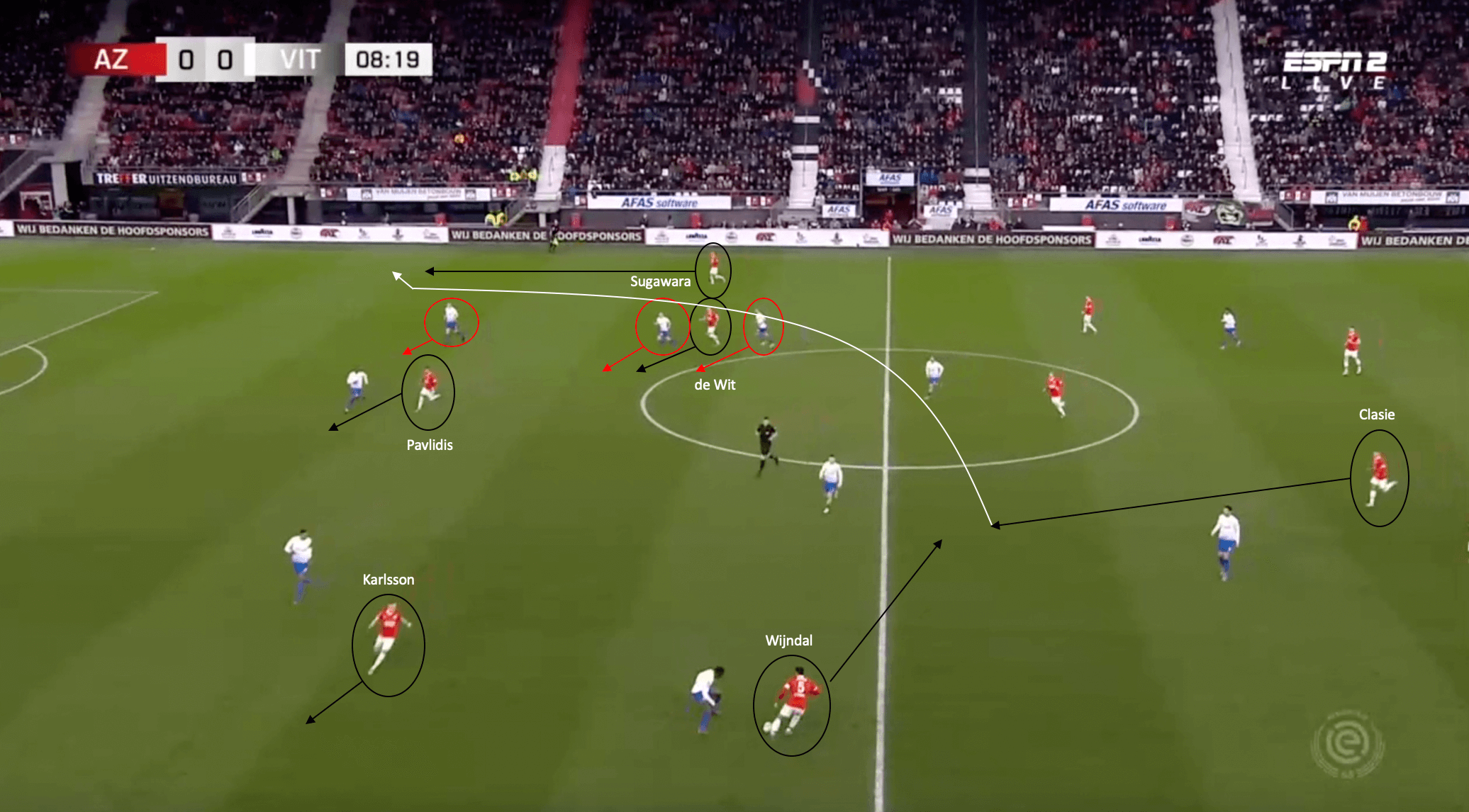
The image above from AZ’s match against Vitesse shows the types of movements that the AZ players make while in possession to create space in the wide channels.
Owen Wijndal is in possession and has the space to cut inside.
At the same time, Karlsson drifts wide left, while both Pavlidis and de Wit drift more centrally, dragging the Vitesse players over with them.
This allows Sugawara to find himself unmarked in the wide channel to make a run in behind the defence.
Wijndal subsequently passes to Jordy Clasie, who, with a switch of play, finds Sugawara’s run.
He then plays a dangerous cross into the box towards who is s, which forces the defender to clear out for a corner.
These off-the-ball movements and switches of play allow AZ to create chances from wide positions, making them a dangerous side when allowed to cross into the box in the final third area.
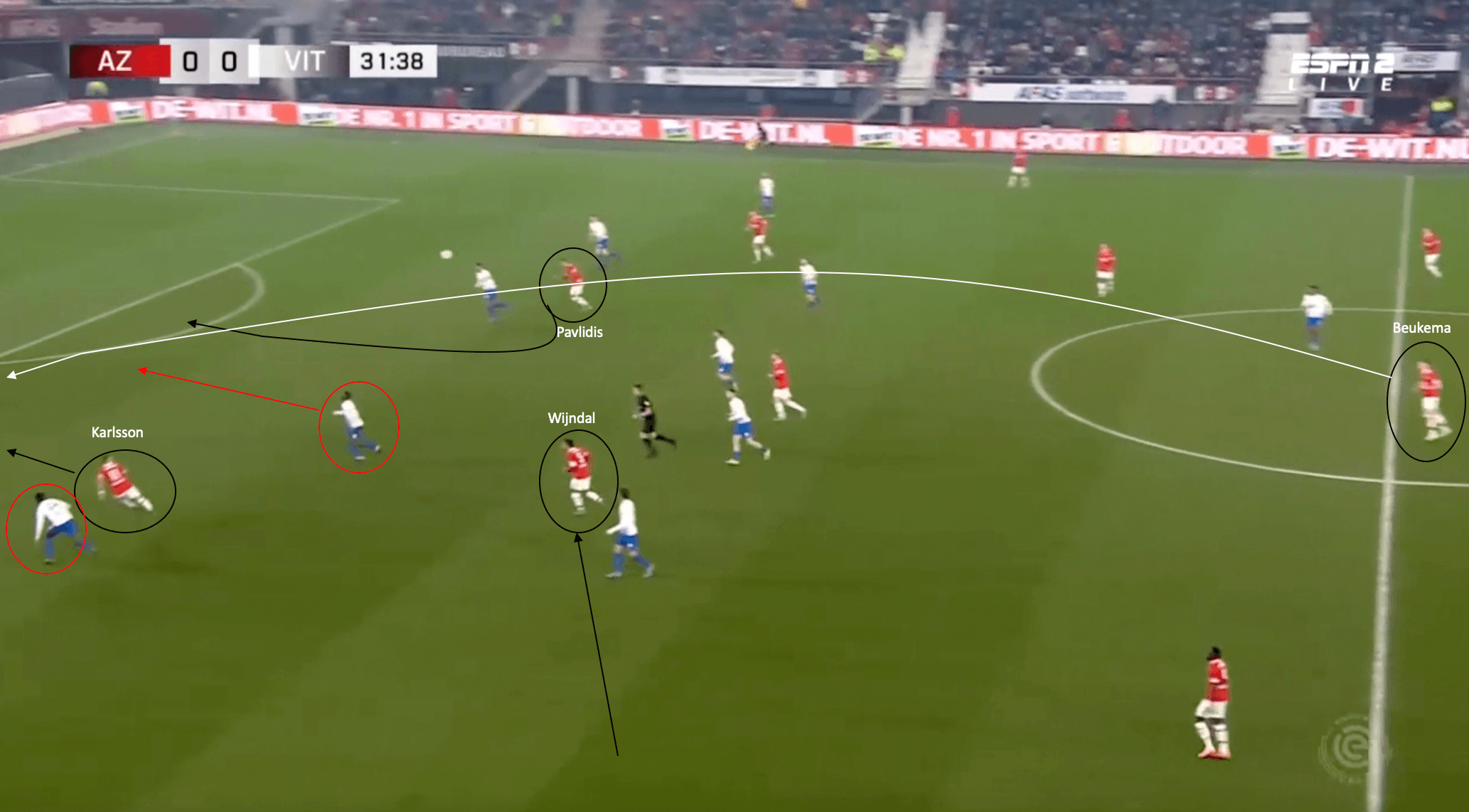
This attacking sequence above leads to an AZ goal and illustrates exactly how they look to create and exploit space in the wide channels.
In this phase of play above, Wijndal tucks inside to become almost a defacto central midfielder, which allows Karlsson to be isolated 1v1 with the opposition fullback.
Pavlidis makes an in-to-out run into the penalty box and positions himself near the penalty spot.
As a result, Beukema is able to play a long ball over the top of the opposition defence and into the wide channel where Karlsson is making a run.
The defender circled in red between Karlsson and Pavlidis gets stuck in two minds over whether to help mark the run of Karlsson in the wide channel; or help with Pavlidis’s run and as a result, just drifts towards the edge of the 18-yard box in no mans’ land.
Karlsson gets onto the end of the long ball and crosses to Pavlidis, who holds the ball up before turning and firing past the goalkeeper.
The AZ players’ constant off-the-ball movements and rotations allow them to create space in the wide channels to manufacture successful crossing opportunities and, as a result, goal-scoring chances.
These differing strategies of creating space in the wide channels are able to keep opponents guessing where the movements will come from.
The crossing accuracy also shows that the AZ players are not constantly trying to send balls into the box from wide areas; instead, they are selective in their crossing to create the best possible goal-scoring chances.
Pascal Jansen Pressing
This next section will examine Pascal Jansen’s pressing structure at AZ and examine how the tactical setup is constructed.
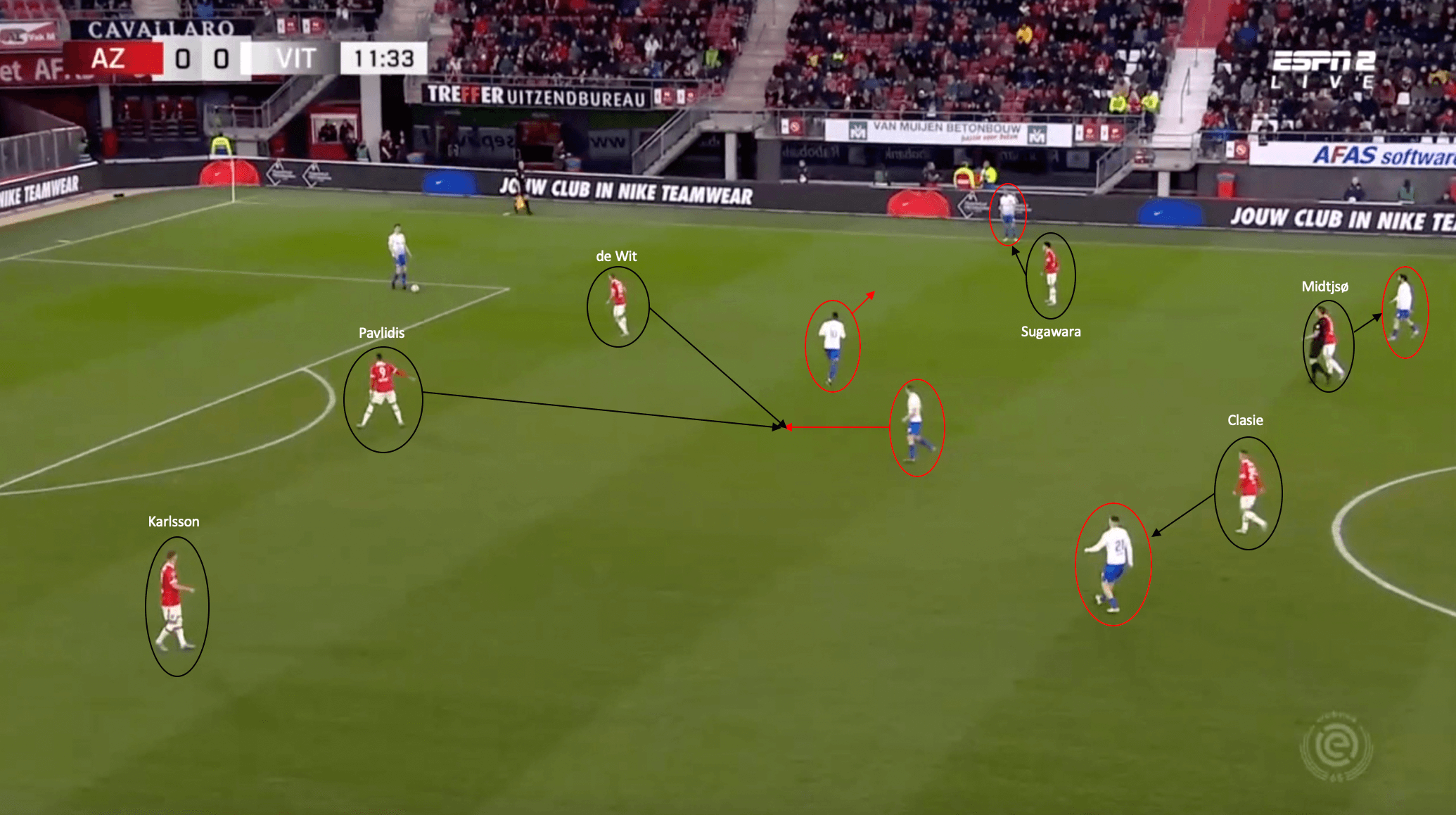
The image above shows AZ’s typical pressing sequence when the opposition defenders are in possession in their own final third.
It is not a heavily aggressive pressing system, but one that relies on man-to-man marking and quick closing down once passes are played to force the opposition into turnovers.
In this pressing sequence, the Vitesse defender in possession passes to the midfielder, who drops into the pocket of space.
Once the pass is played, this triggers the press.
Both Dani de Wit and Vangelis Pavlidis quickly close the receiver down, with de Wit using an angle that prevents the pass from being played to the Vitesse player moving into a wider position.
This forces the receiver to quickly play a pass back to his goalkeeper, who is rushed into a clearance by the onrushing Pavlidis.
As a result, AZ are able to win a throw-in near midfield.
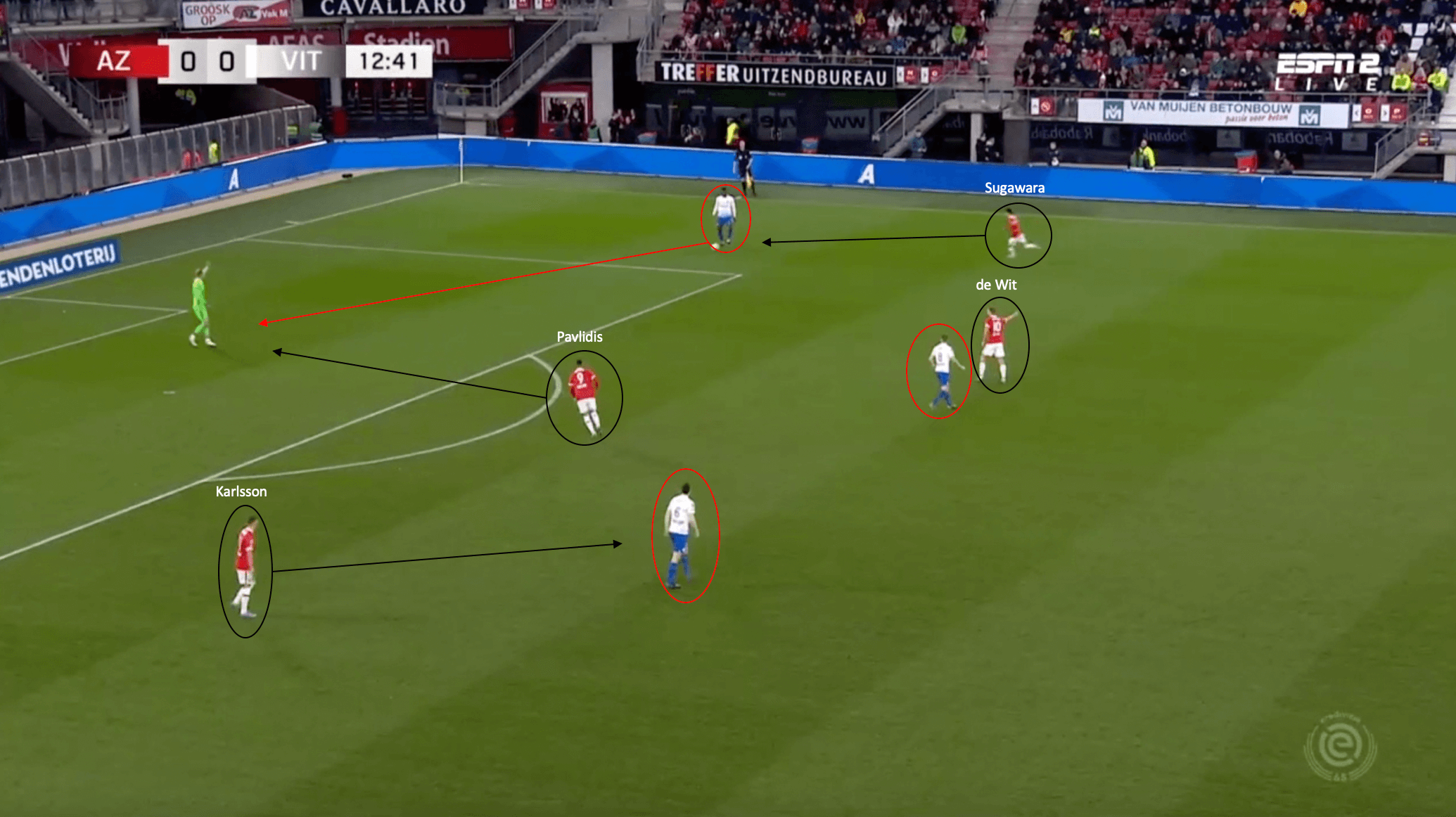
The above shows another example of this pressing structure, once again from AZ’s match against Vitesse.
Once again, the pressing is triggered when the goalkeeper passes the ball out to the defender.
This initiates the press from Sugawara, who forces the defender to play the ball back to his goalkeeper.
This pass then triggers Pavlidis’s press, which forces the goalkeeper into a poor clearance and allows AZ to win back possession near midfield.
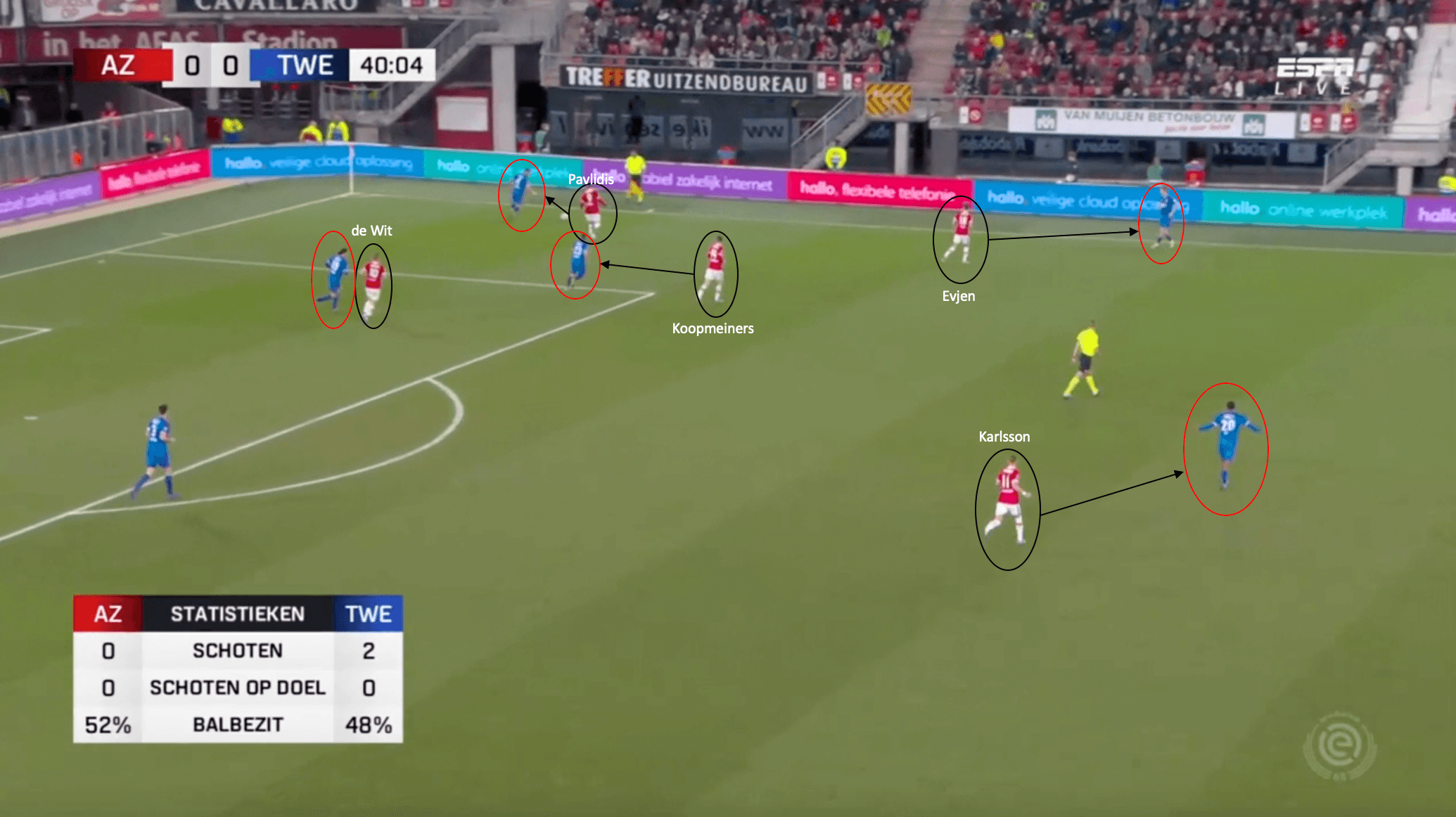
This example from AZ’s match against Twente once again shows this man marking structure when pressing.
In this phase of play, the pressing is triggered once the ball gets played to the fullback near the corner flag.
This triggers Pavlidis to put pressure on the ball receiver, and as with no free options to pass to; he is forced to clear the ball out of play.
As a result of this press, AZ are able to win a throw-in in the opposition’s half, setting them up for a possible dangerous attacking sequence.
Though Pascal Jansen’s pressing structure at AZ is not the most aggressive, like Jürgen Klopp’s Liverpool, it is still able to force the opposition into errors.
While the press does sometimes fail and the opposition gets through it, with fewer players engaging the ball carriers, AZ has more opportunities to win back possession before the opposition reaches the final third.
Role of the goalkeeper during build-up
This final section will examine AZ’s build-up play, with the role of the goalkeeper, Peter Vindahl, who is crucial to how they play out from the back.
Pascal Jansen’s style of play with building out from the back needs a goalkeeper who can play with the ball at his feet, and Vindahl is just that.
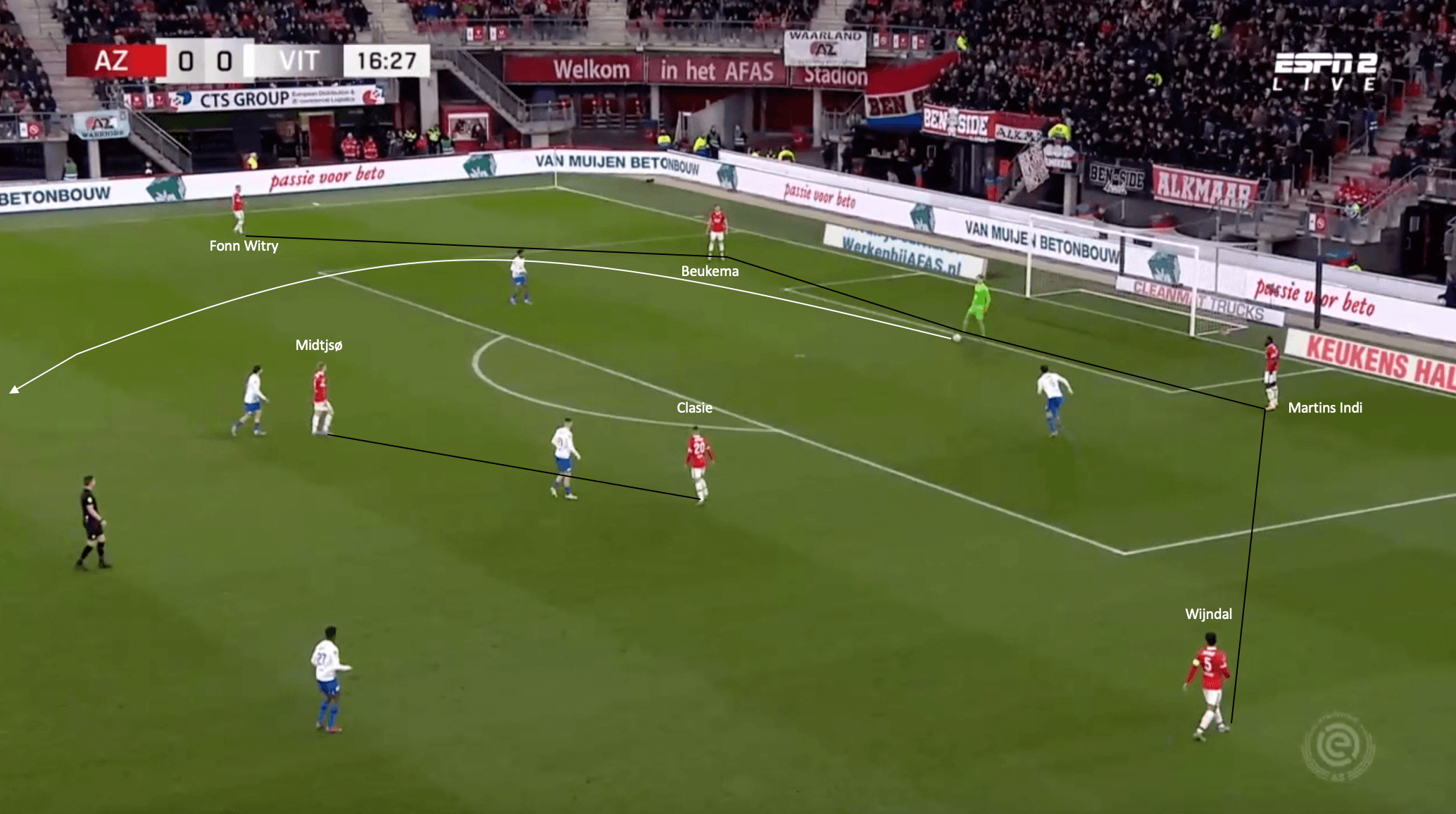
The image above shows an example of how AZ likes to set up during the build-up phases, starting with the goalkeeper.
The two centrebacks will stay on the edge of the six-yard box, and the two fullbacks will go a little higher but keep the width.
The two deeper-lying midfielders will also drop deep, dragging the opposition players deep. This allows the goalkeeper to play a long ball to Pavlidis, who is isolated 1v1 with the defender behind him. This allows him to hold up the play while awaiting the arrival of his teammates pushing up the pitch.
Because the opposition players are in deeper positions during this phase, there is a large gap between the midfield and defensive lines, which Vindahl can exploit by dropping the ball into that space.
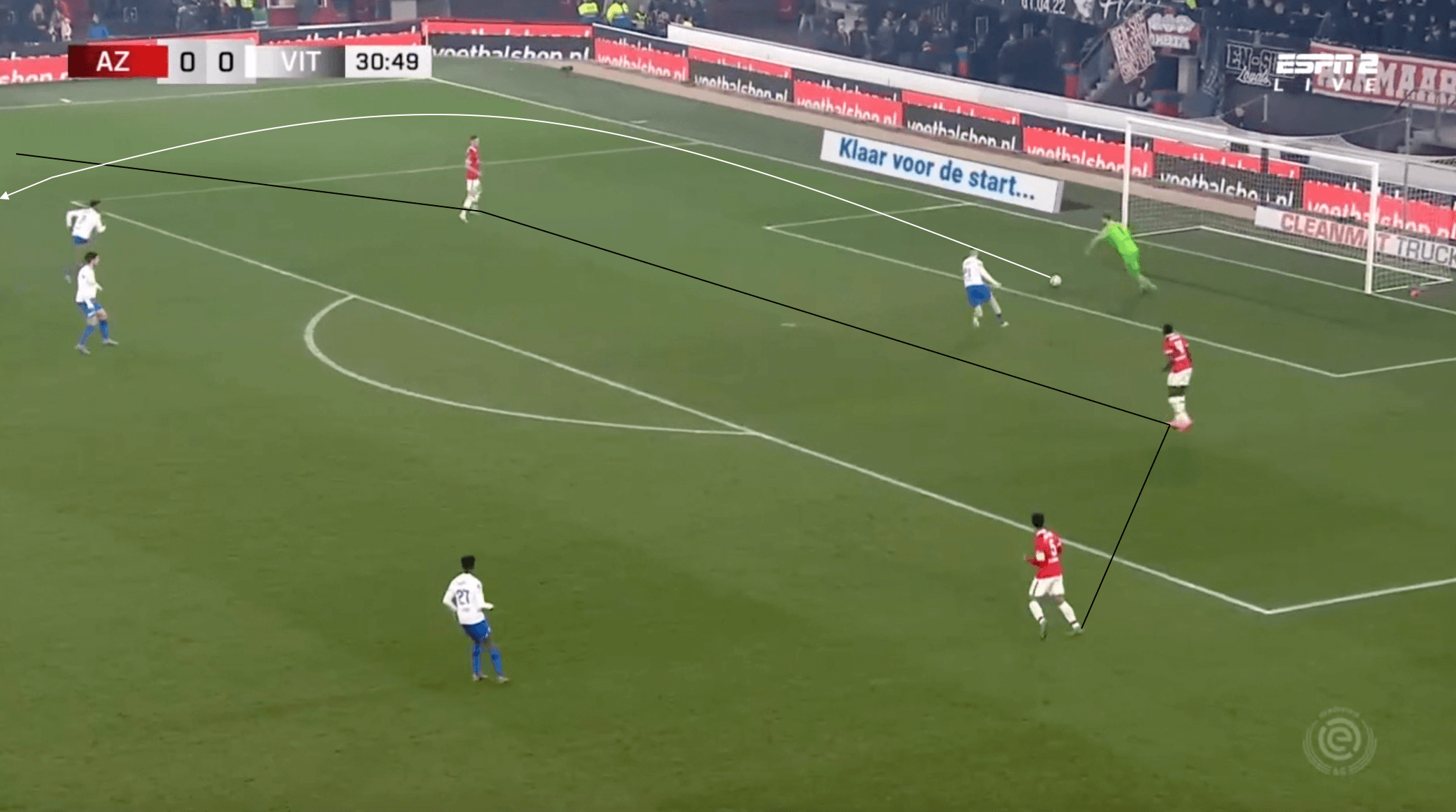
Here again shows how critical Peter Vindahl is to what AZ try to do with their build-up play.
Once again, the backline is positioned the same as before, with the double pivot of Clasie and Midjtsø positioned a bit higher up.
Vindahl is put under pressure from the pressing Vitesse forward.
Still, he is able to once again drop a perfect ball into the space between the lines to Pavlidis, who is able to gather possession and start the AZ attack from the halfway line.
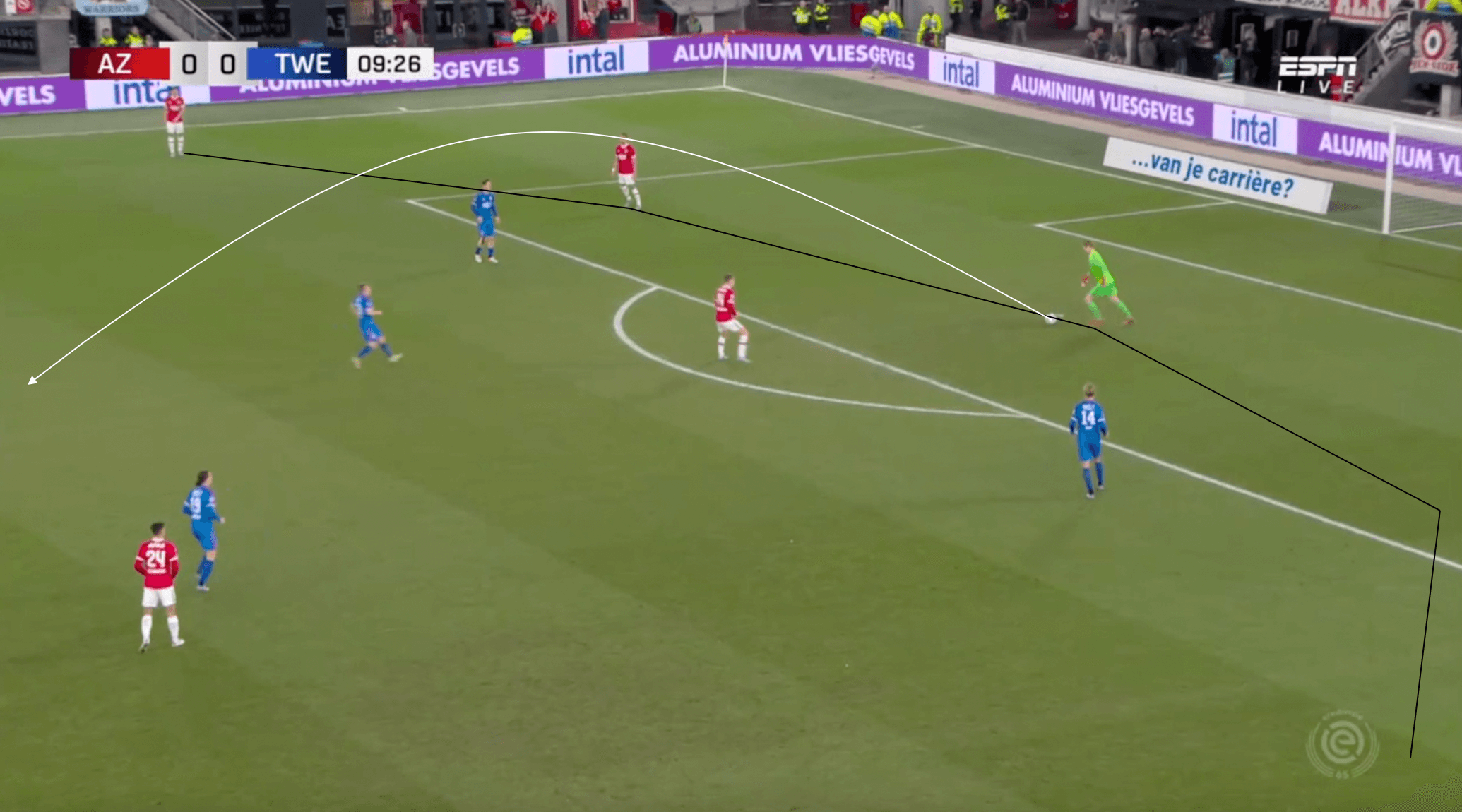
Once again, this image shows the quality that Vindahl has to be able to drop the ball into the vacant space between the lines to find Pavlidis.
In this phase of play against Twente, the backline is in their normal build-up phase positions, with Martins Indi and Wijndal out of the picture.
Vindahl can play the ball short if he chooses to, but the movement of the midfielder dropping deeper allows Vindahl to once again play the ball over the top into the vacant space to find Pavlidis.
This section has shown how key Peter Vindahl is to Pascal Jansen’s plan for AZ to build out from the back.
While AZ also likes to play it short to the centre-backs and build up that way, having a goalkeeper like Vindahl, who is good with his feet, opens up other options as well.
Conclusion
In his first full season in charge of AZ Alkmaar, Pascal Jansen’s coaching style has proven itself in his first senior management job, as this analysis piece has demonstrated by going over some of Pascal Jansens tactics.
With many key players leaving the club last summer, AZ recruited well, and Jansen gelled the squad together nicely.
With Erik ten Hag close to leaving Ajax for Manchester United in the summer, it would not be surprising if Jansen found himself linked to the opening in Amsterdam.





Comments